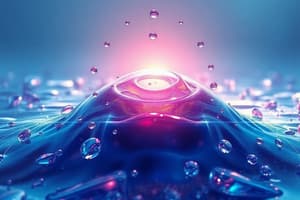Podcast
Questions and Answers
What type of surface is characterized by strong interaction with liquid molecules, leading to dispersion rather than droplet formation?
What type of surface is characterized by strong interaction with liquid molecules, leading to dispersion rather than droplet formation?
- Hydrophobic surface
- Lipophilic surface
- Oleophobic surface
- Hydrophilic surface (correct)
What does a large contact angle indicate about the interaction between a solid and a liquid?
What does a large contact angle indicate about the interaction between a solid and a liquid?
- Low solid-liquid attraction (correct)
- Equal cohesion and adhesion forces
- High solid-liquid attraction
- High liquid-liquid cohesion
Which of the following correctly describes the equilibrium contact angle?
Which of the following correctly describes the equilibrium contact angle?
- It has no relation to the surface free energy.
- It is always smaller than the contact angle measured with a droplet.
- It is influenced by solid, liquid, and air interface interactions. (correct)
- It is solely determined by the properties of the liquid.
Which statement is NOT true regarding contact angles?
Which statement is NOT true regarding contact angles?
If the contact angle is small, what does this imply about the surface properties?
If the contact angle is small, what does this imply about the surface properties?
In which scenario will the liquid likely form drops on a solid surface?
In which scenario will the liquid likely form drops on a solid surface?
What primarily determines the size of the contact angle formed between a liquid and a solid?
What primarily determines the size of the contact angle formed between a liquid and a solid?
Which of the following best describes a hydrophobic surface?
Which of the following best describes a hydrophobic surface?
What is the primary reason for the Lotus Effect observed on the lotus leaf?
What is the primary reason for the Lotus Effect observed on the lotus leaf?
Which measurement technique can be used to analyze the shape of the drop on a sample surface?
Which measurement technique can be used to analyze the shape of the drop on a sample surface?
What happens to a water drop on a super hydrophobic surface according to the Lotus Effect?
What happens to a water drop on a super hydrophobic surface according to the Lotus Effect?
In the contact angle experiment measuring quartz with respect to DAH concentration, what is being primarily evaluated?
In the contact angle experiment measuring quartz with respect to DAH concentration, what is being primarily evaluated?
What is the approximate contact angle for a water drop on a lotus leaf?
What is the approximate contact angle for a water drop on a lotus leaf?
What does a contact angle between 30 and 89 degrees indicate about a mineral's surface?
What does a contact angle between 30 and 89 degrees indicate about a mineral's surface?
What is the significance of the advancing contact angle being larger than the receding contact angle?
What is the significance of the advancing contact angle being larger than the receding contact angle?
If a mineral surface has a contact angle around 90 degrees, what can be concluded about its wettability?
If a mineral surface has a contact angle around 90 degrees, what can be concluded about its wettability?
What does a contact angle approaching 0 degrees suggest about a mineral surface?
What does a contact angle approaching 0 degrees suggest about a mineral surface?
What is the relationship between surface roughness and contact angle?
What is the relationship between surface roughness and contact angle?
Which option accurately describes contact angle hysteresis?
Which option accurately describes contact angle hysteresis?
What is the effect of mineral surface heterogeneity on contact angle?
What is the effect of mineral surface heterogeneity on contact angle?
Which equation represents the equilibrium contact angle based on Young's formula?
Which equation represents the equilibrium contact angle based on Young's formula?
What is the primary factor that affects the flotation of mineral particles?
What is the primary factor that affects the flotation of mineral particles?
Which minerals are characterized as hydrophobic and suitable for flotation?
Which minerals are characterized as hydrophobic and suitable for flotation?
What is the ideal contact angle range for effective flotation?
What is the ideal contact angle range for effective flotation?
Which method is NOT commonly used for measuring contact angles?
Which method is NOT commonly used for measuring contact angles?
What is the function of collectors in the flotation process?
What is the function of collectors in the flotation process?
Why must the buoyancy of the air bubble exceed gravity for flotation to occur?
Why must the buoyancy of the air bubble exceed gravity for flotation to occur?
What is a super-hydrophobic surface characterized by?
What is a super-hydrophobic surface characterized by?
Which equipment is primarily used to measure contact angles?
Which equipment is primarily used to measure contact angles?
What happens at a DAH concentration of 1.10-2 M?
What happens at a DAH concentration of 1.10-2 M?
What is the effect of an amine concentration between 1.10-4 and 1.10-3 M?
What is the effect of an amine concentration between 1.10-4 and 1.10-3 M?
Which of the following concentrations has no contact angle?
Which of the following concentrations has no contact angle?
What is indicated by a high contact angle of approximately 70°?
What is indicated by a high contact angle of approximately 70°?
At which point is flotation recovery at its maximum?
At which point is flotation recovery at its maximum?
What does a contact angle of 0° signify?
What does a contact angle of 0° signify?
What range of recovery percentage is typically expected at amine concentrations between 1.10-4 and 1.10-3 M?
What range of recovery percentage is typically expected at amine concentrations between 1.10-4 and 1.10-3 M?
If flotation recovery is measured at 20%, what might be the cause?
If flotation recovery is measured at 20%, what might be the cause?
What happens to the contact angle as DAH concentration increases from $1.10^{-6}$ M to $5.10^{-4}$ M?
What happens to the contact angle as DAH concentration increases from $1.10^{-6}$ M to $5.10^{-4}$ M?
At what DAH concentration does the flotation recovery first exceed 50%?
At what DAH concentration does the flotation recovery first exceed 50%?
Which DAH concentration results in the highest flotation recovery percentage?
Which DAH concentration results in the highest flotation recovery percentage?
What is the contact angle associated with a DAH concentration of $1.10^{-4}$ M?
What is the contact angle associated with a DAH concentration of $1.10^{-4}$ M?
Which DAH concentration has the lowest flotation recovery percentage?
Which DAH concentration has the lowest flotation recovery percentage?
What relationship exists between contact angle and flotation recovery as DAH concentration increases?
What relationship exists between contact angle and flotation recovery as DAH concentration increases?
At a concentration of $1.10^{-3}$ M, what is the flotation recovery percentage?
At a concentration of $1.10^{-3}$ M, what is the flotation recovery percentage?
Which of the following statements is true regarding the effect of DAH concentration on the contact angle?
Which of the following statements is true regarding the effect of DAH concentration on the contact angle?
What is the contact angle at a DAH concentration of $5.10^{-3}$ M?
What is the contact angle at a DAH concentration of $5.10^{-3}$ M?
Which DAH concentration yields a contact angle closest to 60 degrees?
Which DAH concentration yields a contact angle closest to 60 degrees?
At what DAH concentration does the flotation recovery drop below 10%?
At what DAH concentration does the flotation recovery drop below 10%?
If the flotation recovery is 64.7%, what is the corresponding DAH concentration?
If the flotation recovery is 64.7%, what is the corresponding DAH concentration?
As DAH concentration increases from $1.10^{-5}$ M to $1.10^{-4}$ M, what happens to the flotation recovery?
As DAH concentration increases from $1.10^{-5}$ M to $1.10^{-4}$ M, what happens to the flotation recovery?
Flashcards
Contact Angle
Contact Angle
The angle formed at the point where a liquid droplet meets a solid surface.
Hydrophilic Surface
Hydrophilic Surface
A surface that attracts and spreads out liquid, like water on a clean glass window.
Hydrophobic Surface
Hydrophobic Surface
A surface that repels liquid, causing it to form droplets, like water on a waxed car.
Cohesion Forces
Cohesion Forces
Signup and view all the flashcards
Adhesion Forces
Adhesion Forces
Signup and view all the flashcards
Wettability
Wettability
Signup and view all the flashcards
Contact Angle Measurement
Contact Angle Measurement
Signup and view all the flashcards
Surface Free Energy
Surface Free Energy
Signup and view all the flashcards
Wetting of Minerals
Wetting of Minerals
Signup and view all the flashcards
Flotation
Flotation
Signup and view all the flashcards
Hydrophobic Mineral
Hydrophobic Mineral
Signup and view all the flashcards
Collectors
Collectors
Signup and view all the flashcards
Goniometer
Goniometer
Signup and view all the flashcards
Sessile Drop Method
Sessile Drop Method
Signup and view all the flashcards
Contact Angle Hysteresis
Contact Angle Hysteresis
Signup and view all the flashcards
Advancing and Receding Contact Angles
Advancing and Receding Contact Angles
Signup and view all the flashcards
Effect of Roughness on Contact Angle
Effect of Roughness on Contact Angle
Signup and view all the flashcards
Effect of Heterogeneity on Contact Angle
Effect of Heterogeneity on Contact Angle
Signup and view all the flashcards
Hydrophobicity
Hydrophobicity
Signup and view all the flashcards
Self-cleaning surface
Self-cleaning surface
Signup and view all the flashcards
Hydrophobic coating
Hydrophobic coating
Signup and view all the flashcards
Cohesion
Cohesion
Signup and view all the flashcards
Adhesion
Adhesion
Signup and view all the flashcards
Concentration
Concentration
Signup and view all the flashcards
DAH (Dodecylammonium Hydroxide)
DAH (Dodecylammonium Hydroxide)
Signup and view all the flashcards
Flotation Recovery
Flotation Recovery
Signup and view all the flashcards
Concentration Dependence
Concentration Dependence
Signup and view all the flashcards
Wettability Modification
Wettability Modification
Signup and view all the flashcards
Concentration Dependence of Wettability
Concentration Dependence of Wettability
Signup and view all the flashcards
Correlation of DAH Concentration, Contact Angle, and Flotation Recovery
Correlation of DAH Concentration, Contact Angle, and Flotation Recovery
Signup and view all the flashcards
Critical Concentration
Critical Concentration
Signup and view all the flashcards
Study Notes
Surface and Colloid Chemistry
- This presentation covers the properties of solid-liquid interfaces and surfaces, focusing on contact angles.
- A liquid dropped onto a solid surface either spreads out or forms droplets.
- Strong liquid-solid interactions result in the liquid spreading completely, creating a hydrophilic surface (water-loving).
- Weak liquid-solid interactions lead to the formation of droplets, creating a hydrophobic surface (water-repellent).
Contact Angle
- The angle formed between a liquid surface and a solid surface is the contact angle.
- This angle is determined by the relative strengths of cohesive forces (among liquid molecules) and adhesive forces (between liquid and solid).
- A large contact angle indicates weak adhesion forces.
- A small contact angle indicates strong adhesion forces.
- Contact angles are crucial for understanding how liquids interact with solid surfaces.
- Wettability is related to the contact angle. Low angles mean good wettability and high angles mean poor wettability.
- The contact angle is important in determining the behavior of a liquid on a solid material.
Hydrophilic and Hydrophobic Surfaces
- Hydrophilic surfaces have low contact angles (typically less than 90°).
- Water spreads easily on these surfaces. This means the water molecules are attracted to the solid surface more than they attract each other.
- Hydrophobic surfaces have high contact angles (typically greater than 90°).
- Water beads up on these surfaces. The strength of water-water attraction is greater than the water-solid attraction.
Contact Angle Hysteresis
- Contact angles are not constant. They often vary depending on whether the liquid is advancing or receding on the surface.
- Contact angle hysteresis exists when the advancing angle is significantly different from the receding angle.
Effect of Roughness and Heterogeneity
- Surface roughness and chemical heterogeneity can influence contact angles.
- They can affect the apparent contact angle measurement.
Contact Angle Measurement Methods
- Different methods exist for measuring contact angles, including sessile drop, sessile bubble, captive bubble, and tilting plate methods.
- A goniometer is a common instrument used for contact angle measurement.
- It uses light, lenses, and video cameras and sample positioning.
Contact Angle and Flotation
- Flotation is a technique used in mineral processing to separate desired minerals from unwanted materials.
- Hydrophobic minerals attach to air bubbles, enabling their separation from the liquid phase. This separation process works because of the different contact angles the different minerals have with water.
- Minerals with large contact angles tend to float better.
Lotus Effect
- The lotus effect describes self-cleaning properties observed on lotus leaves, which are based on surface roughness and hydrophobic waxes.
- This effect demonstrates how surface microstructures, combined with the right material, result in very low contact angles, enabling the ease of water-shedding and self-cleaning.
Measuring Advancing and Receding Contact Angles
- Techniques such as the add/remove volume method using instruments like DROPimage Advanced and the ramé-hart Automated Dispensing System can be used.
Theta Optical Tensiometer
- The Theta Optical Tensiometer is an instrument used for contact angle measurement.
- It contains features involving introduction, contact angle analysis, pendant drop measurement, and meniscus measurement.
Studying That Suits You
Use AI to generate personalized quizzes and flashcards to suit your learning preferences.




